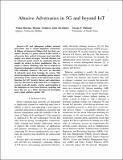Files in this item
Abusive adversaries in 5G and beyond IoT
Item metadata
| dc.contributor.author | Sharma, Vishal | |
| dc.contributor.author | Varghese, Blesson | |
| dc.contributor.author | McAllister, John | |
| dc.contributor.author | Mohanty, Saraju | |
| dc.date.accessioned | 2022-09-26T15:30:22Z | |
| dc.date.available | 2022-09-26T15:30:22Z | |
| dc.date.issued | 2021-05-19 | |
| dc.identifier | 278898989 | |
| dc.identifier | bc7ddbd6-1c2a-4991-adb7-3b5dcae2c94e | |
| dc.identifier | 85107226304 | |
| dc.identifier.citation | Sharma , V , Varghese , B , McAllister , J & Mohanty , S 2021 , ' Abusive adversaries in 5G and beyond IoT ' , IEEE Consumer Electronics Magazine , vol. 11 , no. 4 , 9435931 , pp. 11 - 20 . https://doi.org/10.1109/MCE.2021.3079998 | en |
| dc.identifier.issn | 2162-2248 | |
| dc.identifier.uri | https://hdl.handle.net/10023/26072 | |
| dc.description.abstract | 5G and subsequent cellular network generations aim to extend ubiquitous connectivity of billions of Internet-of-Things (IoT) for their consumers. Security is a prime concern in this context as adversaries have evolved to become smart and often employ new attack strategies. Network defenses can be enhanced against attacks by employing behavior models for devices to detect misbehavior. One example is Abusive Modeling (AM) that is inspired by financial technologies to defend adversaries operating with unlimited resources who have no intention of self-profit apart from harming the system. This article investigates behavior modeling against abusive adversaries in the context of 5G and beyond security functions for IoT. Security threats and countermeasures are discussed to understand AM. A complexitysecurity trade-off enables a better understanding of the limitations of state-based behavior modeling and paves the way as a future direction for developing more robust solutions against AM. | |
| dc.format.extent | 10 | |
| dc.format.extent | 854868 | |
| dc.language.iso | eng | |
| dc.relation.ispartof | IEEE Consumer Electronics Magazine | en |
| dc.subject | QA75 Electronic computers. Computer science | en |
| dc.subject | 3rd-DAS | en |
| dc.subject | AC | en |
| dc.subject | NCAD | en |
| dc.subject.lcc | QA75 | en |
| dc.title | Abusive adversaries in 5G and beyond IoT | en |
| dc.type | Journal article | en |
| dc.contributor.institution | University of St Andrews. School of Computer Science | en |
| dc.identifier.doi | https://doi.org/10.1109/MCE.2021.3079998 | |
| dc.description.status | Peer reviewed | en |
| dc.identifier.url | https://pure.qub.ac.uk/en/publications/abusive-adversaries-in-5g-and-beyond-iot | en |
This item appears in the following Collection(s)
Items in the St Andrews Research Repository are protected by copyright, with all rights reserved, unless otherwise indicated.

